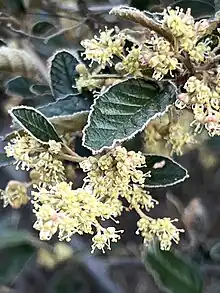Pomaderris oraria
Pomaderris oraria, commonly known as Bassian dogwood,[2] is a species of flowering plant in the family Rhamnaceae and is endemic to south-eastern Australia. It is a compact shrub with hairy branchlets, hairy, elliptic leaves and panicles of hairy, greenish to cream-coloured or crimson-tinged flowers.
| Pomaderris oraria | |
|---|---|
 | |
| At Wilsons Promontory | |
| Scientific classification | |
| Kingdom: | Plantae |
| Clade: | Tracheophytes |
| Clade: | Angiosperms |
| Clade: | Eudicots |
| Clade: | Rosids |
| Order: | Rosales |
| Family: | Rhamnaceae |
| Genus: | Pomaderris |
| Species: | P. oraria |
| Binomial name | |
| Pomaderris oraria | |

Description
Pomaderris oraria is a compact shrub that typically grows to a height of up to 2 m (6 ft 7 in), and has many branchlets with soft greyish to rust-coloured, star-shaped hairs. The leaves are elliptic to egg-shaped, the size depending on subspecies, with densely hairy stipules about 2 mm (0.079 in) long at the base, but that fall off as the leaf develops. The upper surface of the leaves is covered with bristly or felt-like hairs, the lower surface densely covered with woolly white, star-shaped hairs. The flowers are borne on the ends of branchlets or in leaf axils in panicles about as long as the leaves, each flower on a pedicel 0.5–1.0 mm (0.020–0.039 in) long. The flowers are greenish to cream-coloured or tinged with crimson and densely covered with soft, star-shaped hairs. The size of the petal-like sepals varies with subspecies and there are no petals. Flowering occurs in October and November and the fruit is a dry capsule about 3 mm (0.12 in) long.[3][4]
Taxonomy
Pomaderris oraria was first formally described in 1858 by Siegfried Reissek in the journal Linnaea: Ein Journal für die Botanik in ihrem ganzen Umfange from an unpublished description by Ferdinand von Mueller. The type specimens were collected by Charles Stuart in Tasmania.[3][5] The specific epithet (oraria) means "pertaining to the coast".[6]
In 1990, Neville Grant Walsh described two subspecies of P. oraria in the journal Muelleria, and the names are accepted by the Australian Plant Census:
- Pomaderris oraria subsp. calcicola N.G.Walsh[7] that has leaves up to 70 mm (2.8 in) long and sepals 2.0–2.5 mm (0.079–0.098 in) long and 1.2–1.5 mm (0.047–0.059 in) wide;[3][8]
- Pomaderris oraria F.Muell. ex Reissek subsp. oraria[9] that has leaves mostly 10–30 mm (0.39–1.18 in) long and sepals 1.5–2.2 mm (0.059–0.087 in) long and 1.0–1.3 mm (0.039–0.051 in) wide.[2][3][10]
Distribution and habitat
Subspecies oraria grows in near-coastal scrub in deep sand between Cape Paterson and Ninety Mile Beach in eastern Victoria and Badger Head and near Wingaroo on Flinders Island in Tasmania.[2][10] Subspecies calcicola grows on limestone soils where it is often dominant in shrubland in a few locations in eastern Victoria including the Mitchell River National Park.[8]
Conservation status
Subspecies oraria is listed as "rare" under the Tasmanian Government Threatened Species Protection Act 1995.[2]
References
- "Pomaderris oraria". Australian Plant Census. Retrieved 24 March 2022.
- "Threatened species link - Pomaderris oraria subsp. oraria". Government of Tasmania Department of Natural Resources and Environment. Retrieved 24 March 2022.
- Walsh, Neville G. (1990). "The Pomaderris oraria F.Muell. complex in Australia". Muelleria. 7 (2): 269–273. Retrieved 25 March 2022.
- Walsh, Neville G. "Pomaderris oraria". Royal Botanic Gardens Victoria. Retrieved 25 March 2022.
- "Pomaderris oraria". Australian Plant Name Index. Retrieved 25 March 2022.
- Sharr, Francis Aubi; George, Alex (2019). Western Australian Plant Names and Their Meanings (3rd ed.). Kardinya, WA: Four Gables Press. p. 266. ISBN 9780958034180.
- "Pomaderris oraria subsp. calcicola". Australian Plant Census. Retrieved 25 March 2022.
- Walsh, Neville G. "Pomaderris oraria subsp. calcicola". Royal Botanic Gardens Victoria. Retrieved 25 March 2022.
- "Pomaderris oraria subsp. oraria". Australian Plant Census. Retrieved 25 March 2022.
- Walsh, Neville G. "Pomaderris oraria subsp. oraria". Royal Botanic Gardens Victoria. Retrieved 25 March 2022.